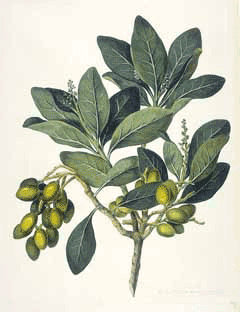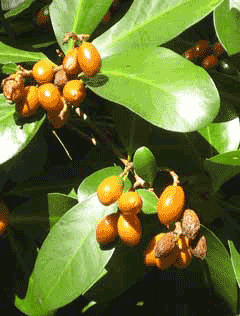 |
|
http://commons.wikimedia.org/wiki/File:Corynocarpuslaevigatus.jpg |
 |
|
Translate this page:
Summary
Physical Characteristics

 Corynocarpus laevigatus is an evergreen Tree growing to 12 m (39ft) by 8 m (26ft).
Corynocarpus laevigatus is an evergreen Tree growing to 12 m (39ft) by 8 m (26ft).
See above for USDA hardiness. It is hardy to UK zone 8 and is frost tender. It is in leaf all year, in flower from May to June, and the seeds ripen from December to February. The species is hermaphrodite (has both male and female organs).
Suitable for: light (sandy), medium (loamy) and heavy (clay) soils. Suitable pH: mildly acid, neutral and basic (mildly alkaline) soils. It can grow in semi-shade (light woodland) or no shade. It prefers moist soil.
UK Hardiness Map
US Hardiness Map
Synonyms
Plant Habitats
Woodland Garden Secondary; Dappled Shade; Shady Edge;
Edible Uses
Edible Parts: Fruit Seed
Edible Uses:
Fruit - raw. Sweet and pulpy[1, 2, 46, 59, 61, 103, 173]. One report says that it is poisonous raw[153], though the writer might have been confused with the seed[K]. Seed - cooked[46, 59, 61, 128]. The seed needs to be soaked in salt water or thoroughly boiled or roasted in order to destroy a deleterious principle[1, 2, 63]. A staple food of the Maoris, it contains a tasteless farinaceous substance[2, 103]. The seed contains about 11% protein and 58% carbohydrate[173].
References More on Edible Uses
Medicinal Uses
Plants For A Future can not take any responsibility for any adverse effects from the use of plants. Always seek advice from a professional before using a plant medicinally.
None known
References More on Medicinal Uses
The Bookshop: Edible Plant Books
Our Latest books on Perennial Plants For Food Forests and Permaculture Gardens in paperback or digital formats.

Edible Tropical Plants
Food Forest Plants for Hotter Conditions: 250+ Plants For Tropical Food Forests & Permaculture Gardens.
More

Edible Temperate Plants
Plants for Your Food Forest: 500 Plants for Temperate Food Forests & Permaculture Gardens.
More

More Books
PFAF have eight books available in paperback and digital formats. Browse the shop for more information.
Shop Now
Other Uses
Insecticide Wood
An insecticide is made from the plant[153]. Wood. The tree trunk is used by the Maoris to make canoes[46, 61]. Carbon Farming Solutions - Industrial Crop: starch (Crops grown for non-food uses. Industrial crops provide resources in three main categories: materials, chemicals, and energy. Traditional materials include lumber and thatch, paper and cardboard, and textiles). Corynocarpus spp. are crops suited to woody agriculture. [1-1].
Special Uses
References More on Other Uses
Cultivation details
Succeeds in ordinary garden soil[1]. Best grown in a woodland garden[166]. Plants are not very frost-tolerant and are only hardy outdoors in the mildest areas of Britain[1]. There is a large tree in Falmouth[59]. Plants tolerate pruning if this is necessary[188].
References Carbon Farming Information and Carbon Sequestration Information
Temperature Converter
Type a value in the Celsius field to convert the value to Fahrenheit:
Fahrenheit:
The PFAF Bookshop
Plants For A Future have a number of books available in paperback and digital form. Book titles include Edible Plants, Edible Perennials, Edible Trees,Edible Shrubs, Woodland Gardening, and Temperate Food Forest Plants. Our new book is Food Forest Plants For Hotter Conditions (Tropical and Sub-Tropical).
Shop Now
Plant Propagation
Seed - best sown in a greenhouse as soon as it is ripe[188]. When they are large enough to handle, prick the seedlings out into individual pots and grow them on in the greenhouse for at least their first winter. Plant them out into their permanent positions in late spring or early summer, after the last expected frosts. Cuttings of half-ripe wood, July/August in a frame[188].
Other Names
If available other names are mentioned here
New Zealand Laurel, Karaka nut, karaka, Cook Islands: koopii.
Germany: Karakabaum.
Hawaii: karaka nut; karakanut; karakaranut; New Zealand laurel.
New Zealand: koopii; kopi; Maori peanut; wairarapa.
Native Range
AUSTRALASIA: New Zealand
Weed Potential
Right plant wrong place. We are currently updating this section.
Please note that a plant may be invasive in one area but may not in your area so it's worth checking.
This plant can be weedy or invasive. Weedy in southern regions of the North Island of New Zealand. It is naturalised and considered invasive in Hawaii.
Conservation Status
IUCN Red List of Threatened Plants Status : This taxon has not yet been assessed.

Growth: S = slow M = medium F = fast. Soil: L = light (sandy) M = medium H = heavy (clay). pH: A = acid N = neutral B = basic (alkaline). Shade: F = full shade S = semi-shade N = no shade. Moisture: D = dry M = Moist We = wet Wa = water.
Now available:
Food Forest Plants for Mediterranean Conditions
350+ Perennial Plants For Mediterranean and Drier Food Forests and Permaculture Gardens.
[Paperback and eBook]
This is the third in Plants For A Future's series of plant guides for food forests tailored to
specific climate zones. Following volumes on temperate and tropical ecosystems, this book focuses
on species suited to Mediterranean conditions—regions with hot, dry summers and cool, wet winters,
often facing the added challenge of climate change.
Read More
Expert comment
Author
J.R.Forst.&G.Forst.
Botanical References
144
Links / References
For a list of references used on this page please go here
Readers comment
© 2010, Plants For A Future. Plants For A Future is a charitable company limited by guarantee, registered in England and Wales. Charity No. 1057719, Company No. 3204567.